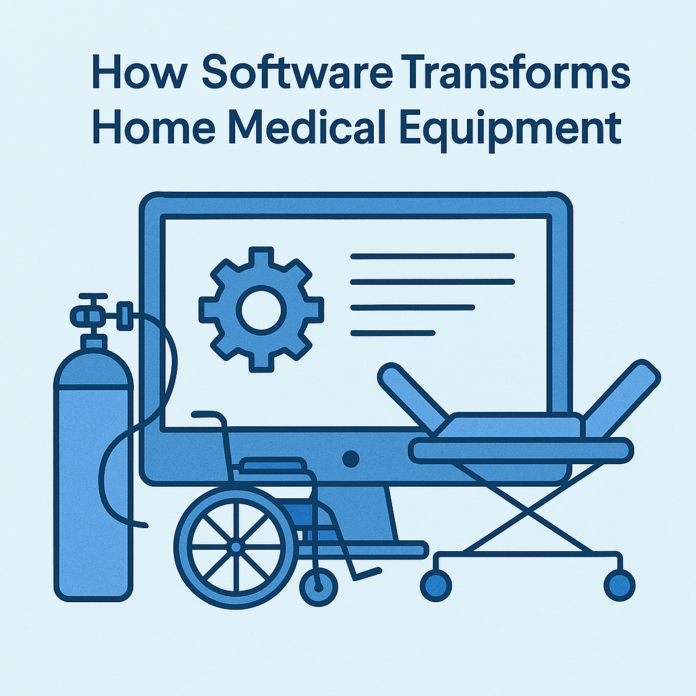Last Updated on May 17, 2025 by Rida Gul
In the large and complicated world of healthcare, there’s a part that works behind the scenes but is very important for patient health—Home Medical Equipment (HME). While many people think of healthcare as hospitals and doctors, HME helps patients stay in treatment and live on their own outside of clinics. As more care moves into the home, it’s time to shine a light on the tools that are making this change possible.
But first, let’s answer the main question: what is HME in healthcare? HME means medical devices and equipment given for home use. They help patients who have ongoing health issues, are recovering from surgery, have trouble moving, or are dealing with long-term illnesses. This includes things like oxygen machines, hospital beds, wheelchairs, and pumps for medicines. These devices need to be delivered and kept in working order. They also need to be tracked, billed, and documented according to strict rules.
That’s where software is important. It is not just a nice thing to have. It is essential for operations.
Table of Contents
HME’s Critical Role in Modern Care
The increasing need for HME is connected to changes in both people and healthcare systems. More people are getting older. Hospitals are encouraged to shorten patient stays. Both patients and doctors now choose care at home when it makes sense. Because of this, HME has become a main part of the care process instead of just a minor issue.
But with growth comes challenges. Providers must manage inventory, understand payer rules, schedule deliveries, and make sure devices are used and cared for correctly. Unlike regular retail logistics, medical equipment has extra steps: checking insurance, keeping clinical records, educating patients, and following government rules. A single mistake, like missing a form or delivering equipment late, can lead to denied claims, increased checks from regulators, or a bad outcome for the patient.
This is why software solutions made for the HME world are not only helpful—they’re very important.
Why HME Needs Purpose-Built Software
The HME sector is not like any other. It is at the point where healthcare, logistics, and finance meet. This special place leads to special challenges. Software made for regular retail or healthcare often does not work well. It fails to understand the details of this field.
Take documentation as an example. Each order of HME usually needs a prescription, proof that it is needed for medical reasons, patient consent, and sometimes extra paperwork for insurance approval. If you miss even one of these documents, it can slow down patient care and lead to claim denials.
Next, we have compliance tracking. Equipment needs to be kept in good shape and replaced on a schedule set by manufacturers and regulatory groups. Tracking this information by hand is not dependable and becomes harder to keep up with as it grows.
And there is billing. Payers like Medicare and Medicaid have strict rules on how to show and get paid for equipment use. The billing process can be long and hard unless it is helped by smart automation.
This is where tools like CPR+ software stand out. It is made for the pharmacy and home infusion market. CPR+ combines order processing, clinical paperwork, and billing. It meets the needs of HME providers well. By linking patient data with delivery and money tasks, it allows providers to work with speed and precision that manual systems cannot match.
NikoHealth: A New Standard in HME Workflow
Legacy systems such as CPR+ have set the stage for digital change. However, newer companies are taking things to the next level. NikoHealth is a good example of new software that meets the current needs of HME operations. It focuses on the importance of complete automation and being accessible in the cloud.
NikoHealth aims to make every step in the HME process easier. This includes everything from taking orders to tracking deliveries and gathering documents. By making things simpler for staff and patients, the platform helps providers work more efficiently. It also allows them to offer better care to their patients.
What makes companies like NikoHealth different is how fast they respond to today’s problems. They provide easy-to-use interfaces, instant reporting, and smooth connections with payers, suppliers, and electronic health records. This level of connection not only speeds things up but also cuts down on mistakes and slowdowns, which are still too frequent in HME logistics.
The Bigger Picture: Patient-Centered Care Through Tools
At its heart, the HME industry focuses on helping patients feel respected, safe, and free at home. A child needing special equipment for a rare illness or an older person healing from surgery both need providers. They require the right tools and the peace of mind that their care is in good hands.
Software makes this happen. It helps providers deliver equipment on time, get digital signatures, check insurance coverage right away, and send reminders when service is needed. In a field where timing and precision affect health results, digital systems are as important as the medical devices.
As healthcare shifts to a value-based system, the focus is on results, not just services. HME providers will face more scrutiny on how well they manage care, follow rules, and prevent readmissions. The right software is essential. It helps meet these goals and is key to reaching them successfully.
Final Thoughts
The HME space is changing in a big way. As care for patients moves to their homes, there is a rising need for smart and careful operations. Software designed for the HME/DME world is not just helping providers manage things. It is allowing them to take charge.
Platforms like CPR+ software and smart companies like NikoHealth are changing what can happen in home healthcare. They are taking a field that is often weighed down by paperwork and making it a place where data is used right away. This is good for providers and for patients as well.

























